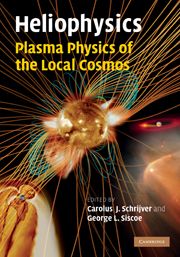Book contents
- Frontmatter
- Contents
- Preface
- 1 Prologue
- 2 Introduction to heliophysics
- 3 Creation and destruction of magnetic field
- 4 Magnetic field topology
- 5 Magnetic reconnection
- 6 Structures of the magnetic field
- 7 Turbulence in space plasmas
- 8 The solar atmosphere
- 9 Stellar winds and magnetic fields
- 10 Fundamentals of planetary magnetospheres
- 11 Solar-wind– magnetosphere coupling: an MHD perspective
- 12 On the ionosphere and chromosphere
- 13 Comparative planetary environments
- Appendix I Authors and editors
- List of illustrations
- List of tables
- References
- Index
3 - Creation and destruction of magnetic field
Published online by Cambridge University Press: 05 August 2013
- Frontmatter
- Contents
- Preface
- 1 Prologue
- 2 Introduction to heliophysics
- 3 Creation and destruction of magnetic field
- 4 Magnetic field topology
- 5 Magnetic reconnection
- 6 Structures of the magnetic field
- 7 Turbulence in space plasmas
- 8 The solar atmosphere
- 9 Stellar winds and magnetic fields
- 10 Fundamentals of planetary magnetospheres
- 11 Solar-wind– magnetosphere coupling: an MHD perspective
- 12 On the ionosphere and chromosphere
- 13 Comparative planetary environments
- Appendix I Authors and editors
- List of illustrations
- List of tables
- References
- Index
Summary
Introduction – magnetic fields in the universe
Objects in the universe from the scale of a planet to the size of a galaxy show evidence of large-scale magnetic fields. Despite the fact that the physical conditions in such objects are quite different, the creation and destruction of magnetic fields is closely linked to turbulent motions of a highly conducting fluid within these bodies. Dynamo theory focuses on the characterization of conditions under which a flow of highly conducting fluid can sustain a magnetic field against resistive decay. This chapter is an introduction to dynamo theory with a primary focus on general concepts rather than detailed applications; the latter are discussed in Vol. III of this series. We start this introduction with a brief overview of the properties of objects with large-scale magnetic fields in the universe.
The Earth and other planets
The magnetic field of the Earth has a strength of about 0.5 gauss and a mainly dipolar character. Currently the dipole axis is tilted by about 11° with respect to the axis of rotation. From studies of rock magnetism (when rocks cool below the Curie point they preserve the magnetic field that was present in them at that time) it is known that the Earth has had a magnetic field over the past 3.5 × 109 years and that the strength and orientation of the field has varied significantly on time scales of 103 to 104 years.
- Type
- Chapter
- Information
- Heliophysics: Plasma Physics of the Local Cosmos , pp. 42 - 76Publisher: Cambridge University PressPrint publication year: 2009
- 2
- Cited by



